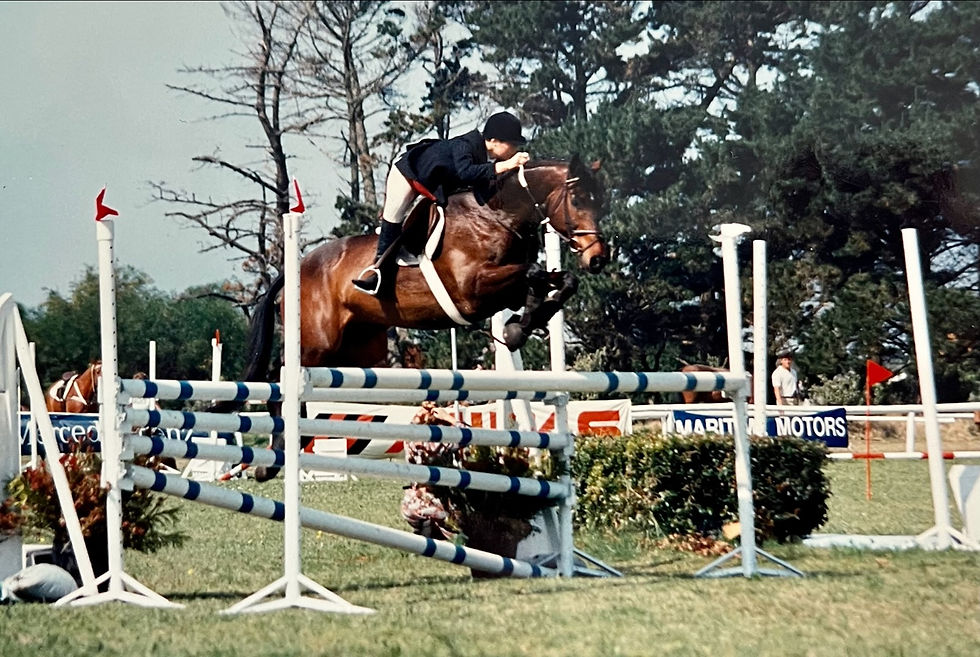Off The Track Thoroughbreds
- Dyan Vorster
- May 30, 2022
- 4 min read
Updated: Jan 31, 2023
“Short cuts make long delays.” – J.R.R Tolkien

Hunting Blue my off-the-track thoroughbred
I admit to having a soft spot for Thoroughbreds. In South Africa in the 80’s and 90’s almost everyone sourced their competition horses from the racetrack. This was by far the most cost-effective way to buy a promising young horse. A very select and privileged few bred their own horses, or imported warm bloods, but they were few and far between and by and large we all rode OTTB’s (off-the-track thoroughbreds).
This is not an endeavor I would recommend for the novice rider who needs the benefit of a school master first, before attempting to train a young horse. However, for the more experienced rider it can be an incredibly rewarding experience.
Our first attempt at retraining OTTB’s was with two horses called Grazinsky and Thunder Chariots. My dad and I went out to our local race track to check them out, and were fortunate enough to be allowed to take them on their morning training gallop (not something that would ever be allowed in the US). After purchasing them, we decided to allow them to run one last time as they were entered in a race that weekend. It was tremendously exciting as Grazinsky ended up coming in third, and I will never forget our brief foray into riding and owning racehorses!
All horses have personalities and character traits. And just like people, there are those you will hit it off with right away, and others you will never get along with. Grazinsky and I were one of those combinations that were obviously not meant to be. I like a horse who is sensitive and smart, Grazinsky was neither, and from the get-go everything about him irritated me. I ended up persevering with him for about a year before selling him on to a rider more suited to his temperament.
Green horses require endless amounts of time and patience, and this is particularly true of racehorses. A young horse that is being introduced to a rider for the first time has its challenges (more about that in my next blog), but a racehorse comes with the added challenge of having to unlearn all the bad habits formed on the racetrack.
Racehorses are bred and trained to…well race, and it is important to keep this in mind when you begin your training. Your young horse may react negatively to your seat and leg aids (remember jockeys don't ride with their seat and legs, so this is a whole new experience for him). Like a tightly coiled spring he may jog, crabwalk, resist your leg by moving backwards, or overreact by shooting forwards, shake his head and snatch at the bit, or do a very good impersonation of a giraffe. The important thing to remember is that there is no substitute for patience and consistency. Thoroughbreds are highly sensitive and are not like other more mellow breeds. Quarter horses, for example, will take a fair amount of pressure, but if you push a TB too hard it will blow their brains, and you will accomplish nothing - aside from setting your training back considerably!
I always start working with my young horses from the ground, in the round pen. This serves a threefold purpose: Firstly, groundwork helps to build a rapport with your horse, developing respect and trust. Secondly, lunging with a Chambon helps them to achieve a level of relaxation which is hard to achieve from the saddle (at least in the early stages), and working in the correct frame helps them develop the muscles they need to work correctly by developing their topline. Thirdly, groundwork helps them to learn to respond to simple voice commands which will better help them to understand your seat and leg aids when you begin work in the saddle.
Fortunately, I had better luck with my second off-the-track purchase. Hunting Blue was a beautiful 6-year-old bay gelding who had all the makings of a first class show jumper. As part of his initial schooling, I competed with him in some Hunter Jumper classes. I admit that I have never enjoyed the show ring. The whole idea that you are completely at the whim of a judge who has all sorts of prejudices and biases is anathema to me. Add to that the shear tediousness of enduring the mind-boggling boredom of standing around waiting in the arena as everyone rides the same pattern, and I can’t imagine why anyone would think submitting themselves to that kind of torture is fun!
However, having said that, showmanship, equitation, and hack or hunter classes do offer great opportunities for young riders and horses to gain experience in the ring. Since showing was obviously not my forte, you can imagine my surprise when Hunting Blue and I were selected for the Eastern Cape Showing Team that year. Showing in the South African Championships was certainly an eye-opening experience - and like all the opportunities offered me over the years, helped mold and shape me as a rider. I was very grateful to Hunting Blue for giving me the experience, however (happily) it was one I never repeated!

Hunting Blue competing in the Working Hunter at SA Champs



Comments